We’re already at the Summer of 2020 and drones are flying off the shelves. As such, if you’re looking to explore and improve your skills in this genre of aerial photography so that you can capture both stunning videos and photos of rare panoramic views, then choosing the right drone for you is obviously an important step to take beforehand, as you wouldn’t want to go with a random drone brand that you’d regret about purchasing later regret. This brings us to the PowerVision PowerEgg X Explorer Drone.
The PowerVision PowerEgg X Explorer Drone is the world’s first drone that can pick up sound, and that works thanks to its SyncVoice patented technology, which automatically synchronizes the sound picked up by your phone’s microphone with the pictures, ultimately putting an end to all silent aerial photography.
Not only that, but this compact drone that can fly for a maximum of 30 minutes and provide dedicated photographers that are passionate about aerial photography with up to 3.7 miles of HD Image Transmission.
With the PowerEgg X Explorer Drone you’re guaranteed to get a drone that’s easy to use, as well as easy to fly and control, which not only comes packed with tons of different quality of life features, but also offers its users up to three different usage modes working either as a drone (it’s main mode), as your personal AI-Camera, or ultimately, as a a standard handheld camera.
Now, let’s have a more detailed look at PowerVision’s brand-new state-of-the-art drone and check everything that this aerial photography gizmo has to offer.
DESIGN & SPECS
Starting with its design, the PowerEgg X Explorer Drone is a very compact drone model, and as such, the entire unit measures exactly 19 inches long by 25 inches wide by 5 inches tall (and 16.8 inches when it comes to its diagonal measurements) when using the drone in its main mode (Drone Mode – using it as a Drone), and the unit weighs exactly 1.9 lbs.
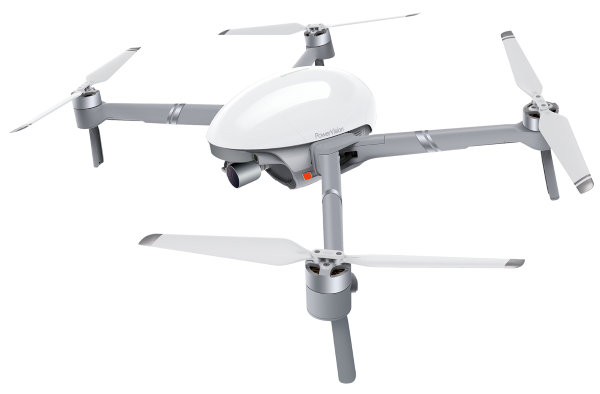
Additionally, when having the drone fully closed/retracted and used as your personal A.I. Camera (having the drone sitting stationary), the unit measures just 7 inches long by 4 inches wide by 4 inches tall, and because it won’t have its full set of arms and propellers equipped, it will also weigh a bit less, 1.2 lbs. to be exact.
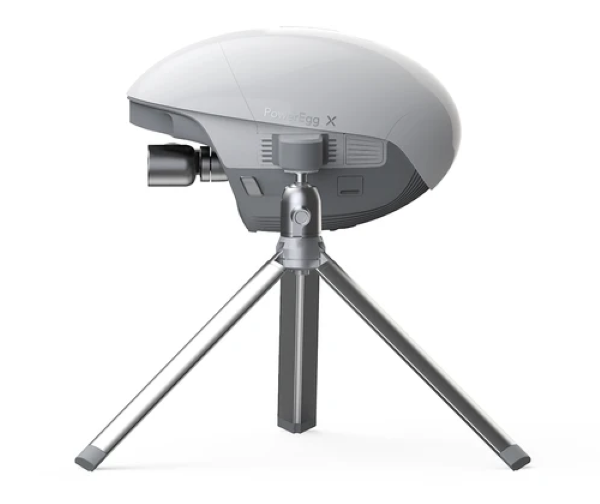
It’s also worth to mention that a tripod does not come included, so, if you’d like to use the drone as your dedicated A.I. Camera, you’ll either have to mount the drone on a tripod that you already have, or ultimately, buy one.
The unit features a very compact design and quite a durable build. When using the PowerEgg X Explorer in its main mode (meaning in Drone Mode), the PowerEgg X works as a high-performance drone that’s suitable for professional dynamic aerial photography thanks to its 4K/60fps camera and triaxial mechanical gimbal.
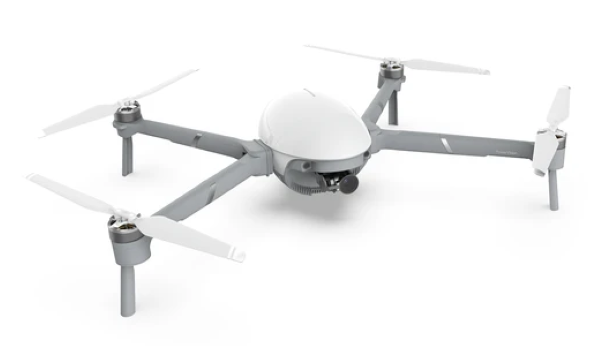
Thanks to its stable build, the drone features a maximum wind speed resistance of 29-38 kph, meaning around 20 knot Wind Resistance, which translates to a Maximum Wind Resistance Level 5. This ultimately allows the drone to stably fly in both coastal and windy conditions.
Additionally, the PowerEgg X Explorer Drone features a Maximum Flight Speed of exactly 40 mph, a Maximum Ascent Speed of 11.2 mph and a Maximum Descent Speed of 6.7 mph.
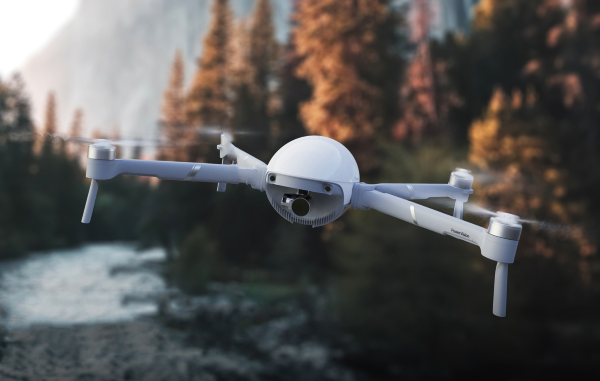
The drone also features a Maximum Service Ceiling Above Sea Level of 2.5 miles and a Maximum Flight Time of exactly 30 minutes.
As mentioned before, users can also control real-time 1080P image transmission (HD Image Transmission) within a distance of 3.7 miles (FCC), meaning the drone’s Maximum Flight Distance.
The drone also comes equipped with a dedicated GNS System (Global Navigation Satellite System) that integrates both GPS and GLONASS.
Additionally, all of the drone’s operations are powered by its built-in industry-leading 13-core AI multiprocessor, which works together with a 5-core high-performance CPU, a single-core GPU, and a 4-core DSP. All these components communicate within the drone’s dual-core neural network engine booster, which is powered by a small single-core MCU (Microcontroller Unit) that features a hashrate as high as 4Tops.

Lasty, since the drone is built to last, it features a special Nano-Optical Coating within all of its frame, which makes it suitable to fly on any harsh environments, including heavy rain.

CAMERA & REMOTE CONTROLLER
Camera Specs & Features
Moving on to the drone’s pièce de résistance, which is of course its high-quality camera. The PowerEgg X Explorer Drone comes equipped with a 4K UHD (Ultra High Definition) camera that can shoot 4K videos at 60 fps.
This camera integrates a high-quality 1/2.8 inch CMOS Sensor that features a Pixel Effectiveness of 12 million pixels. At the same time, the camera’s premium lens features a field of view of 78.4 degrees and a Focal Length of 27mm, as well as a f/1.8 Camera Aperture and a Shooting Range that can literally go from as little as 3.2 ft to pretty much infinite (as long as you can see it, you can shoot/record it). The camera’s electronic shutter features a Shutter Speed of 8–1/8000s.
However, despite the drone’s camera’s standard field of view of 78.4 degrees, the PowerEgg X Explorer Drone’ camera can ultimately track a field of view that can go up to 170°. This is based on the drone’s automatic recording composition technology, which always forces the drone’s camera to put you right at the center of the picture.
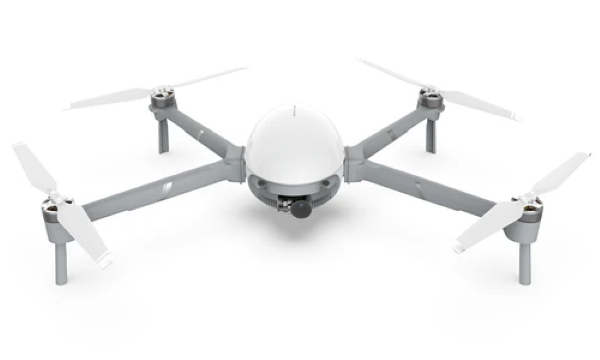
This basically means that no matter if you’re looking to shoot an indoor selfie or an outdoor sports scene, the PowerEgg X can perfectly frame you at the center of all of your recorded photos and videos.
Not only that, but the PowerEgg X can even automatically remember a subject, so even if a person decides to move beyond the drone’s field of view and then move back in, the PowerEgg X will resume to tracking that subject.
The camera lens’ ISO Range (meaning its light sensitivity) ranges between 100 (low sensitivity) to 6400 (somewhat close to a high light sensitivity) for photos and between 100 (low sensitivity) to 3200 (medium light sensitivity) for videos.
Moreover, the drone’s camera also integrates a triaxial (3-axis) Mechanical Gimbal Stabilizer that’s ultra-durable, and extremely sturdy, making it very shake resistant. This sturdy 3-axis Gimbal Stabilizer ultimately provides the drone with super smooth image stabilization, as it efficiently filters out any possible vibration that can caused by external sources (wind, rain, etc.).
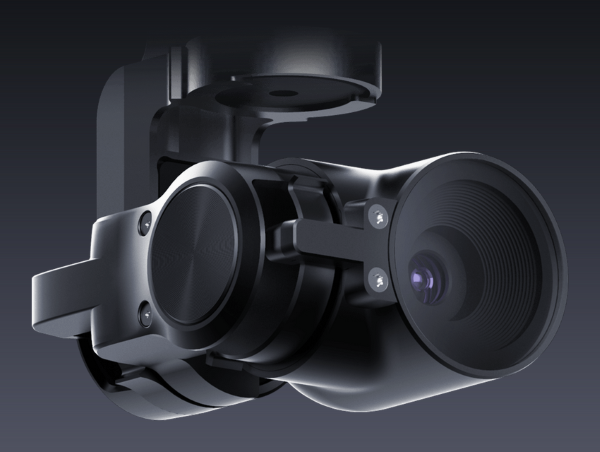
When compared to ordinary photography, both its anti-shake effect and photography quality are simply superior.
Check the two short videos embedded below to see the difference (first using Standard Photography and second is the PowerEgg X Explorer Drone, which heavily relies on its sturdy 3-axis Gimbal Stabilizer to capture a perfect smooth video).
Using Standard Photography
Using the PowerEgg X Explorer Drone
Drone’s Remote Controller
The PowerEgg X Explorer Drone also comes with its own dedicated remote controller that’s used to fully control both the drone and all of its recording features.
The drone’s remote controller feature a really nice ergonomic design and the controller’s sticks also feel really easy to move, as well as very precise. The controller comes equipped with a built-in 3500 mAh rechargeable Li-Ion Battery that will last you quite a long while before you need to recharge it.
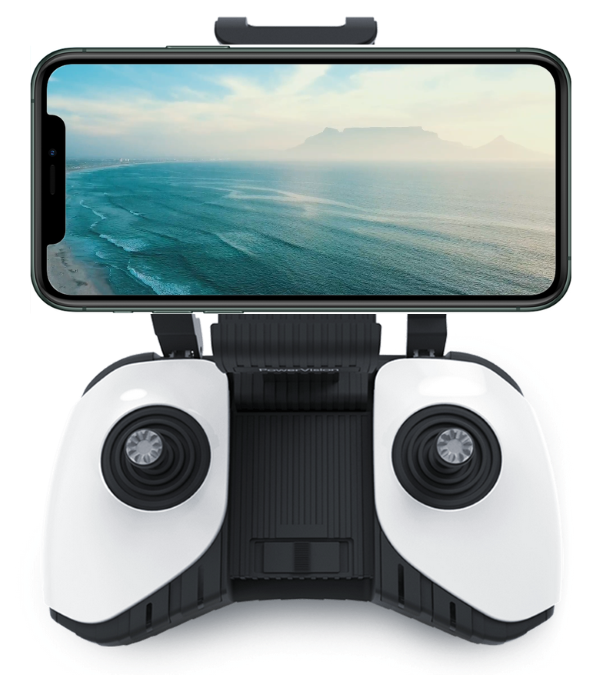
The remote controller operates at several different Operating Frequencies, including FCC/IC (2412~2462MHz), CE (2412~2472MHz), SRRC (2412~2472MHz), and MIC (2412~2472MHz) and it works at a Maximum Transmission Distance of 3.7 miles when using it with its FCC Operating Frequency, or 1.85 miles when using it with either its CE or SRRC Operating Frequencies.
All of these values are for an unobstructed (free of interference) transmission experience, meaning when you have nothing between the drone’s remote controller and the drone itself (several trees, walls, buildings, etc.).
The drone’s controller supports any Smartphones with a maximum thickness of 0.32 inches, and a width range that can go between 2.6 to 3.3 inches. For people that are worried about their Smartphone’s connectivity options, you’ll be glad to know that this controller supports both USB-C, Micro USB (Type-B), and Lightning ports.
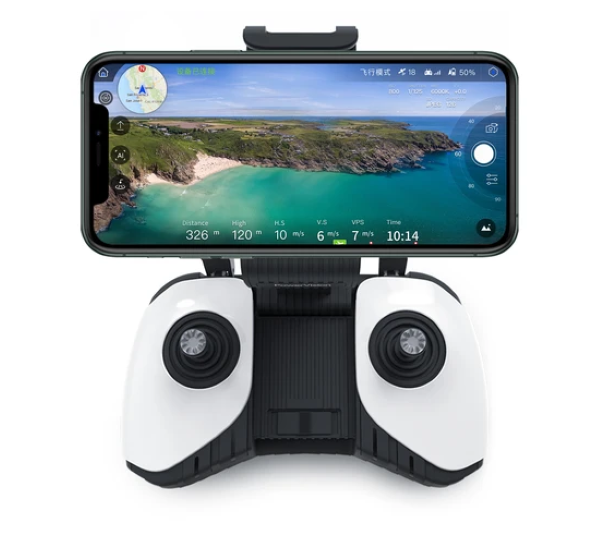
Lastly, once thing that I’m really glad to mention is that after mounting your Smartphone device onto the controller, you Smartphone’s screen will stay right at the front and center, meaning that it will be elevated up, right above the controller’s sticks, which kind of pushes it up right where your eyes fall (look at).
OTHER CAMERA SPECS
Using the Drone for Photos
Users can use their PowerEgg X Explorer Drone to shoot in several different Still Photography Modes, including: Single shot, Burst Shots (at 3/5/7 frames), Auto Exposure Bracketing (AEB) (with either 3 or 5 bracketed frames at 0.7 EV Bias), and Interval Shots (at 3/5/7/10/15/30/60 seconds).
Using the Drone for Videos
Furthermore, they can also use the drone to record high-quality video footage with a Video Resolution of 4K (exactly 3840×2160 resolution at either 24/25/30/48/50/60p), a FHD Video Resolution (meaning a 1920×1080 resolution at 24/25/30/48/50/60/120p) or simply a Standard HD Video Resolution (which is exactly 1280×720 resolution at 24/25/30/48/50/60/120/240p).
When using the drone to capture videos, the drone’s camera will record video at a Maximum Video Bitrate of 75 Mbps.
Additionally, users can also record in Slow Motion, as well as take Quick Video Shots in five (x5) different modes, which are: Dronie, Rocket, Circle, Ellipse, and Helix.
File Storage
When it comes to its file storage, the drone supports both FAT32 (≤32 GB) and exFAT (>32 GB) file systems, saving its users’ photos in either JPEG or RAW and its users’ videos in either MP4 or MOV (H.265/H.264/MPEG-4 AVC).
Storage Capacity & Expandability (Extra Storage Memory)
The PowerEgg X Explorer Drone features a standard Internal Storage of 6 GB and a Maximum Storage Capacity of 128 GB (when using a Micro SD Card to expand its storage capacity).
For users that are looking to expand the PowerEgg X Explorer’s storage memory, know that a Micro SD is also supported for the drone’s SD Card Slot, but you’ll have to be using a Class 10 or a UHS-3 Micro SD Card.
BATTERY & BATTERY LIFE
Now, moving on to the drone’s internal battery, the drone comes equipped with an internal 3800 mAh (11.4 V / 43.32 Wh) LiPo 3S Intelligent Battery that can offer up to 3.5 Hours of battery life.
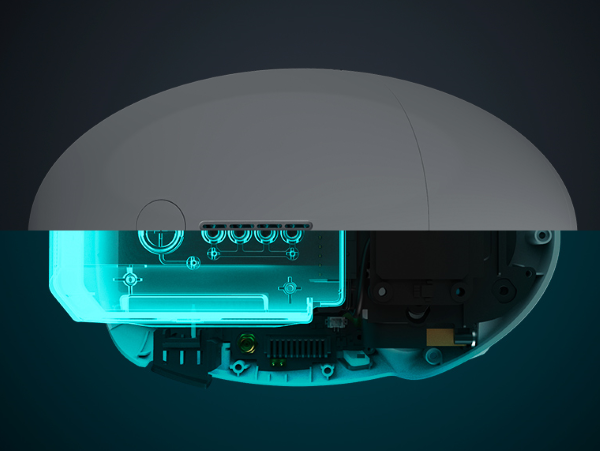
This battery supports a Maximum Charging Voltage of 13.2 V and a Maximum Charging Power of 50 W.
Be aware that these 3.5 hours of battery life are for when using the drone in AI Camera Mode. For its main Drone Mode (Flight Mode), you get around 30 minutes of flight time (battery life).
The drone’s battery level indicator can be seen right at the top of the drone’s body (around the center), which basically lights up with different level indicators according to tis battery life status.
Lastly, charging the drone’s battery can be easily done by connecting the drone’s included charger and Micro-USB charging cable to the the drone’s Micro-USB port.
WHAT’S IN THE BOX?
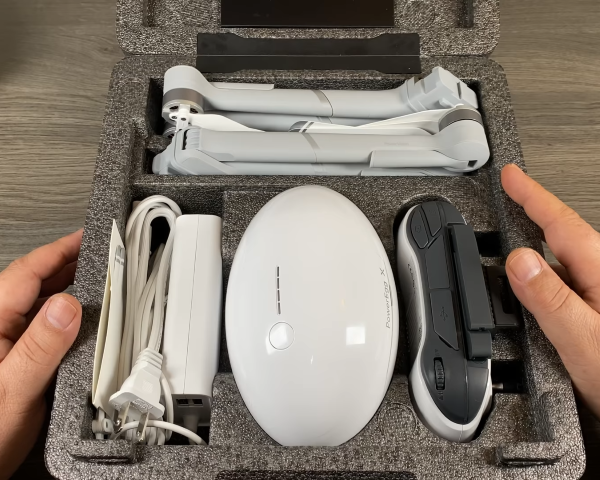
The PowerEgg X Explorer Drone comes neatly packed inside a durable Storage and Carrying Case.
Inside it, users will find: their PowerEgg X Drone, the drone’s proprietary Remote Controller, a mountable Wrist Strap (to use the drone in Handheld Mode), a Full Set of Arms and Propellers (which are mounted to the drone to use it in its Main Mode, the Flight Mode), an included spare pair of Propellers, the drone’s attachable Intelligent Battery, and the drone’s included Intelligent Charger, a small Carrying Bag (for the drone’s accessories), and a User Manual.
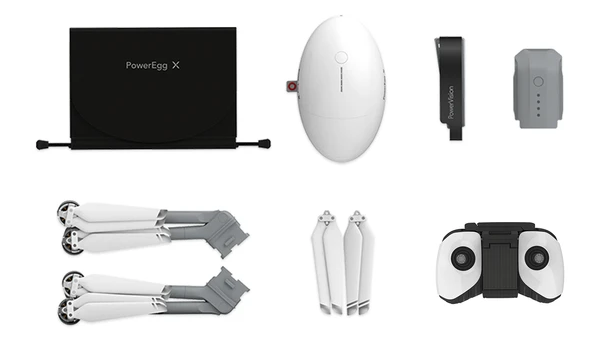
OTHER NOTABLE FEATURES
3 Different Usage Modes
As mentioned at the beginning of the article, the PowerEgg X Explorer Drone can be used in three (x3) different modes and those are Drone Mode (or Flight Mode), Autonomous Personal AI Camera Mode, and Handheld Mode.
Drone Mode (Flight Mode)
In Drone Mode, the PowerEgg X delivers its main purpose, meaning it works as a high-performance drone that’s is suitable for highly dynamic aerial photography thanks to its 4K/60fps camera and triaxial mechanical gimbal.
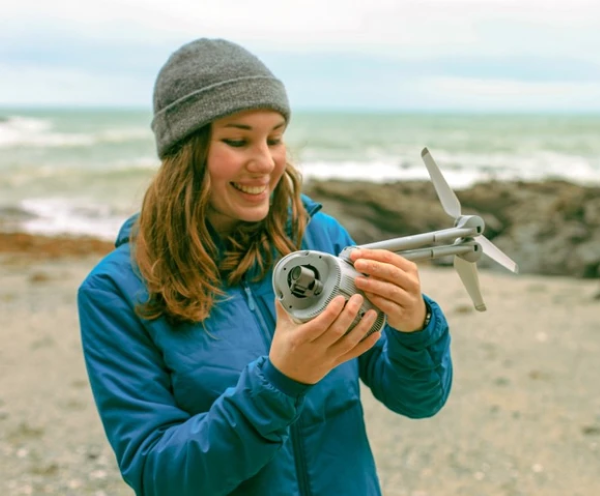
As pointed out earlier, users can control real-time 1080P image transmission within a maximum distance of 3.7 miles (when using the drone’s controller in FCC frequencies), and the drone can be used to record both Dynamic shots as well as Static shots.
Autonomous Personal AI Camera Mode
Furthermore, the PowerEgg X also features strong face recognition capabilities, and so, it can be used as your very own Autonomous Personal AI Camera after the drone is mounted on a tripod (which must be purchased separately).
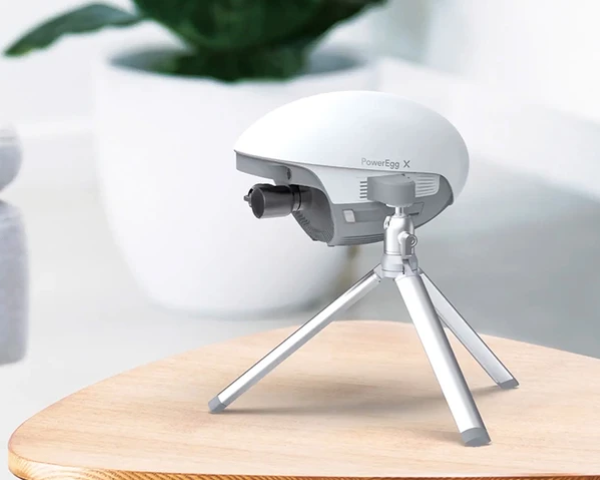
Its face recognition accuracy is continuously improved through deep learning training so that the drone’s camera can always follow a specific object when shooting either a photo or recording a video.
Additionally, this intelligent composition mode also works for general shots and selfies, which ultimatley helps to improve its users’ photography experience.
Hand-held Gimbal Camera Mode
While the PowerEgg X is obviously a drone, it can also be used as a hand-held gimbal camera to capture any ground-level action, whether that’s in picture or video format.
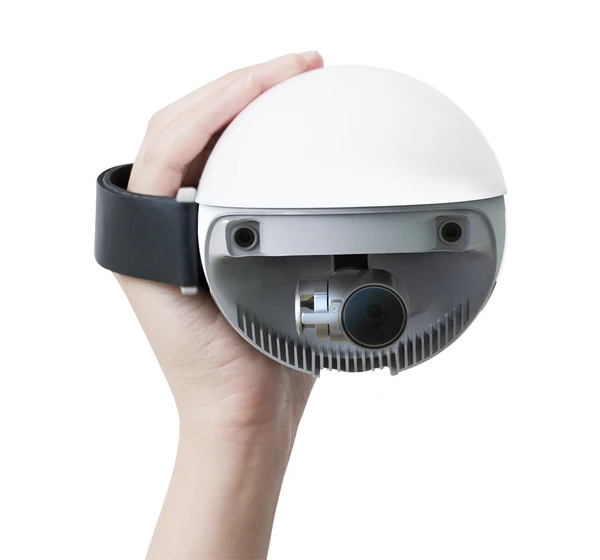
To achieve that, all you have to do is open up the drone’s top lid, carefully remove the drone’s arms and propellers, and mount its Wrist Strap Accessory to the drone’s right side.
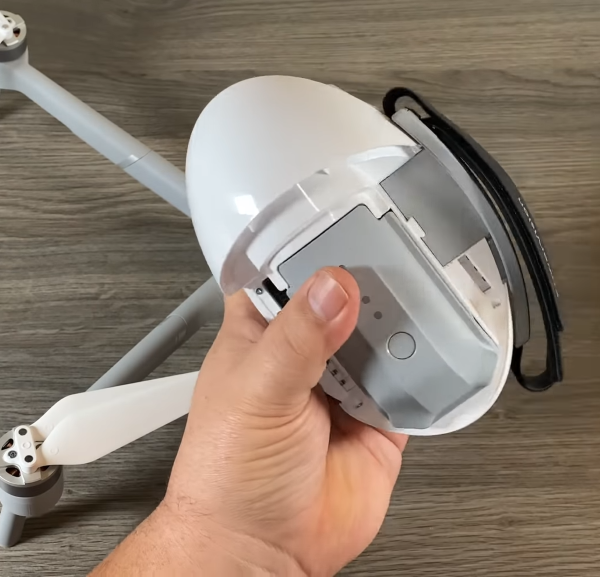
When using the drone in its hand-held mode, the PowerEgg X can be used to capture memorable moments, anytime and anywhere, and that can ultimately be achieved thanks to the combination of the drone’s triaxial mechanical stability augmentation gimbal and Autonomous Personal AI Camera technology.
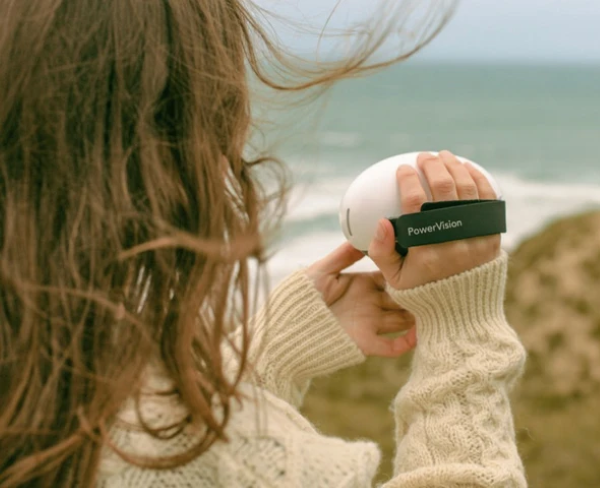
Automatic Obstacle Avoidance & Precision Landing
The PowerEgg X Drone also features front and bottom binocular depth measurement techologies, which ultimately allow the drone to very accurately detect its current distance from any obstacles within a range of 65 feet from the drone.
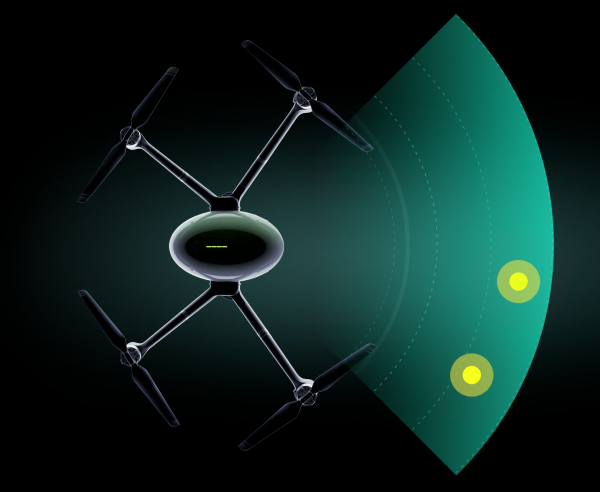
Since this is always done in real-time, the drone can always land safely and precisely, avoiding rocks, tree trunks, and pretty much any other debris that might have a negative impact on the drone’s smart landing.
AI Face Recognition
The PowerEgg X Drone also features the company’s Face Recognition and Deep Learning technologies, which are built on non-identifiable global big data.
That basically means that this drone supports facial recognition and automatic composition to ultimately adapt its shooting capabilities to the facial features of different people.
As such, the drone’s camera can deliver accurate, efficient, multi-angle, remote face recognition, as well as subject lock-on.
Remote Sound Pickup via Sync Voice Technology
As mentioned at the beggining of the article, the PowerEgg X Drone is the world’s first drone that can pick up sound.
This is done by using the company’s SyncVoice patented technology, which automatically synchronizes the sound picked up by your Smartphone’s microphone with the drone’s recorded pictures, allowing you to never again have to deal with a silent aerial photography experience.
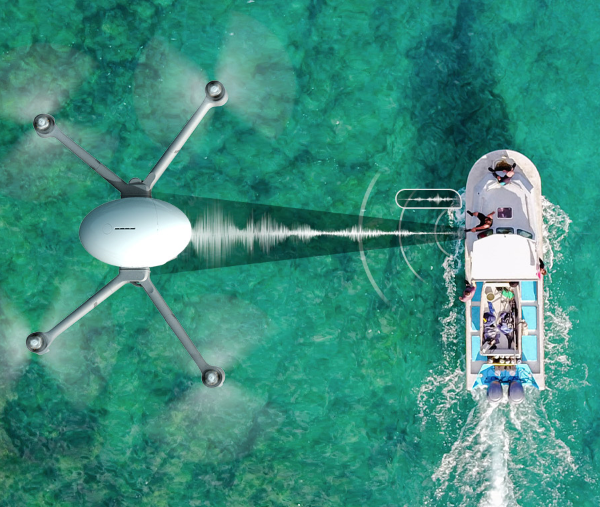
This SyncVoice technology can pick up high-fidelity sound by using the your Smartphone’s microphone (or even a pair of wireless headphones) and automatically synchronize the audio with the pictures that are being recorded by the drone.
Gesture Controls
When using the drone as your Autonomous Personal AI Camera, it will only take a gesture for the PowerEgg X to understand you.
As the PowerEgg X Drone features a deep learning techonology that’s based on a database of gestures, it also supports multi-gesture intelligent recognition for photos, videos, subject tracking, and group photos.
As such, by simply standing in front of the drone’s camera and making a gesture, the drone will understand what you’re trying to do. Whether that’s waving goodbye, flexing or smiling, the drone’s camera will regnonize it and perfectly frame your entire body and the included gesture onto your currently recording picture or video.
THE SMARTPHONE COMPANION APP – The Vision+ 2 App
By using the drone’s proprietary Smartphone Companion App, which is simply called the Vision+ 2 App, users can have In-App Editing for their recorded photos and videos, as well as Instant Sharing features for several Social Media Platforms (Facebook Live, YouTube, etc.)
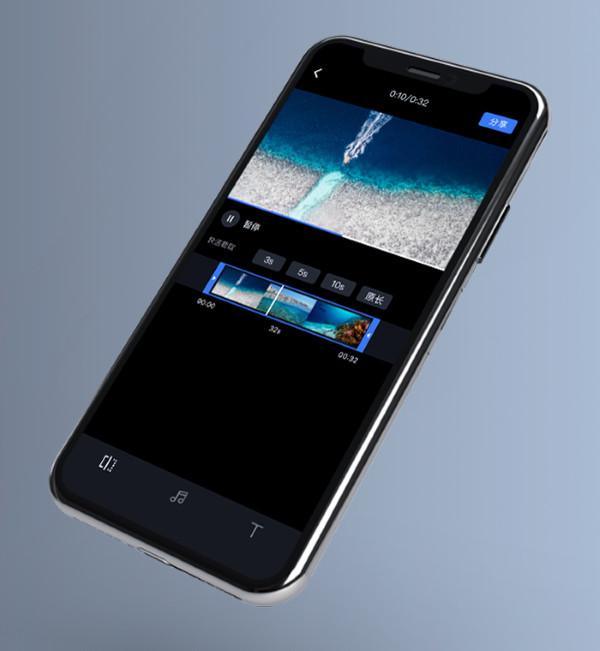
The Vision+ 2 App is available to download for free for both iOS (iOS 10.0 or later) and Android (Android 5.0 or later) devices.
FINAL THOUGHTS
The PowerVision PowerEgg X Explorer Drone is a high-quality drone that features 30 minutes of flight time with 3.7 miles of HD Image Transmission, 3.5 hours of handheld or tripod recording, and a ton of smart features that make using it the best drone recording experience you’ll ever get.
These include its SyncVoice patented technology, its AI Face Recognition, its Automatic Obstacle Avoidance and Precision Landing, and much, much more.
If you’re interested in buying it, the PowerEgg X Explorer Drone is currently going for $899 per set. You can order yours right now, directly from PowerVision’s official shopping page, which you can access by clicking here.





